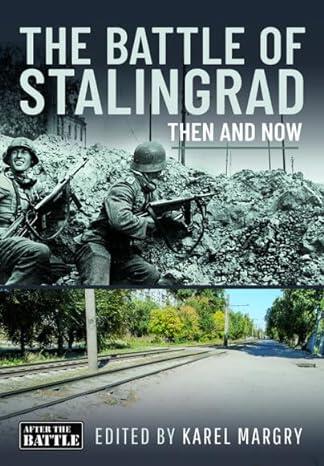The Battle of Stalingrad: Then and Now

You may or may not be familiar with After The Battle Magazine. A quarterly publication that began in 1973, it ended its production history with issue 195 in May of 2022. Since acquired by Pen and Sword Books Ltd., many of its long-standing editors continue to run the company - with a new focus on updating past content and presenting it in book format.
The Battle of Stalingrad: Then and Now is one of several such publications that have since been released. Of those long-serving editors, Karel Margry played the lead role in not only putting together this particular book; but authoring (as taken from a prior edition of After The Battle magazine) one of the three parts into which the book is divided. Perhaps another more famous name associated with this book is that of Jason Mark - whose wide range of publications I cannot recommend enough. In particular, those with an interest in the Battle for Stalingrad should familiarize themselves with the tremendous research and published efforts he has made to make that epic fight more accessible to the general military history enthusiast.
As mentioned, The Battle of Stalingrad is divided into three chapters. The first is dedicated to the Battle of Voronezh that took place early in Operation Blue (the 1942 German summer offensive that culminated at Stalingrad over seven months after the campaign began). The second tackles the fighting in Stalingrad, and the third describes the production history of the film Stalingrad released early in the 1990s. This book and its peers are really ideal for those of you who never regularly read After the Battle Magazine. For American readers that is likely most people.
Another reason I am endorsing this work relates to a concept that is helpful for those interested in history and seeking to understand it better. The combination of past and contemporary pictures regarding battle locations is of a great service for those of us with a passion for history, but maybe not the time or means to travel around the world and visit those places. It also helps those of us trying to better wrap our heads around not only what happened and why it did, but how geography or a given urban layout influenced battles such as those for Voronezh and Stalingrad displayed in the first two thirds of this book. As anyone with an interest in military history, tactics, or strategy knows - understanding the lay of the land is of tremendous importance.
I particularly enjoyed the chapters on Voronezh and Stalingrad. It's one thing, for instance, to read about the combat that raged in Central Stalingrad during the fall of 1942. It's quite another to get a high-quality look at the actual layout and locations where that battle took place. For instance, the way that Central Stalingrad slopes down to the Volga (as seen in these pages) helps highlight even more the impressive defensive effort that was required to hold off the German assault and deny the complete capture of Central and Southern Stalingrad. Had both those parts of the city been completely subjugated in a timely manner, then it is very difficult to see how the defenders of the still imposing (as photographed here) Factory District could have held out alone for long.
To understand how and why complex events like the fight for Stalingrad ended up the way that they did, it is my belief that one must consume as much high quality research they can to buttress the proverbial meat and potatoes of primary documents. Photographic research can in this way be a powerful adjunct to operational military history, memoirs, and other such secondary sources. It is for those reasons that those with an interest in the combat on Germany's Eastern Front during the Second World War (and, realistically speaking, a person who has not already read the After the Battle magazine issues this book is based upon) will find this work worthy of their time.



Post new comment